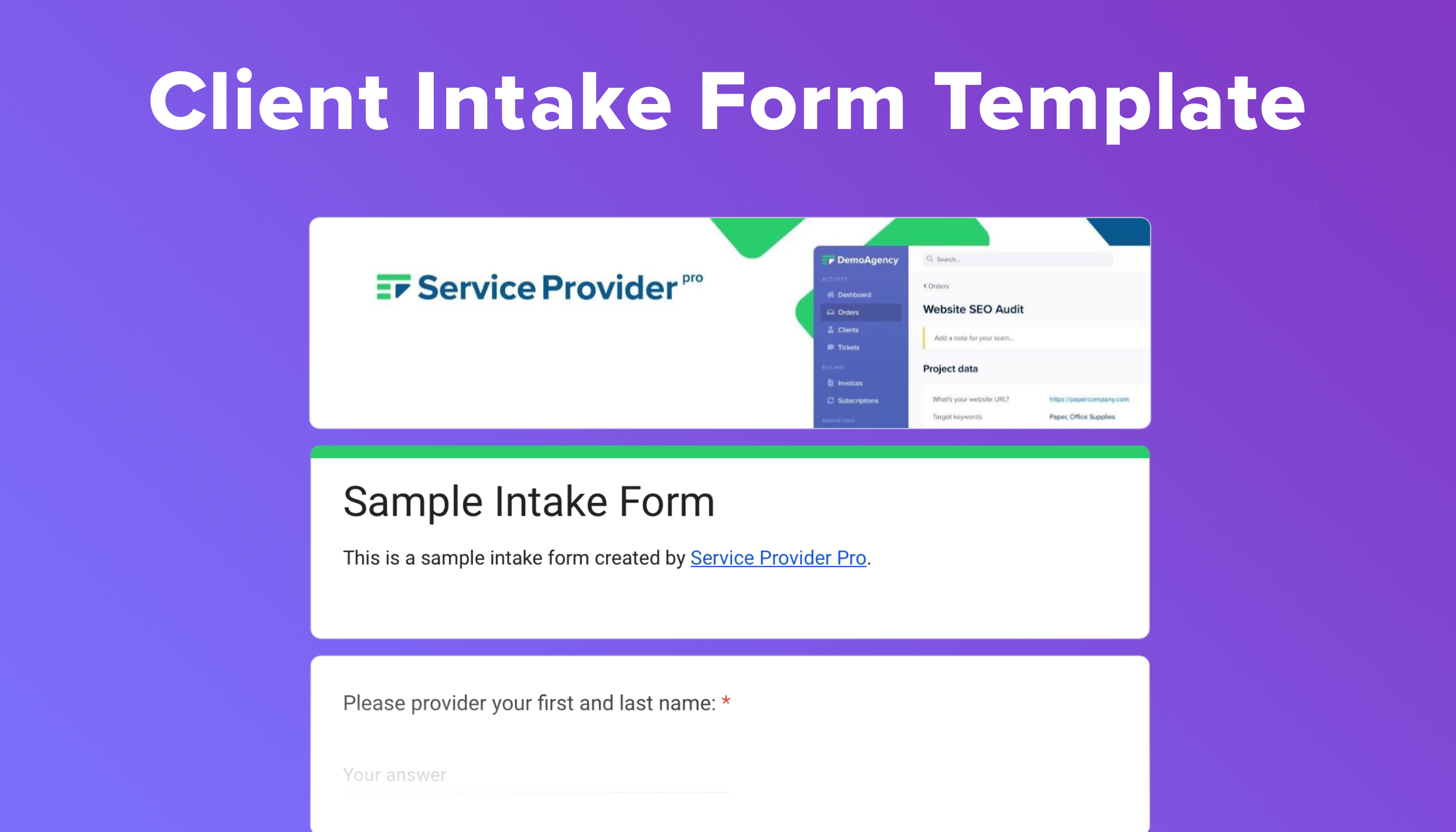- Define what kind of information you need in order to create an accurate intake form that doesn’t overwhelm clients.
- Form builders such as Service Provider Pro allow you to create flexible intake forms that are different for each service.
- Structure your intake form in a way that it only asks the most essential information so you can deliver your services.
Agencies and other service-based businesses heavily rely on client input in order to deliver their work. Those who are successful have set up a project intake form that captures the necessary data, makes it available to the entire team, and is safely stored in a client portal.
If you haven’t been able to create a client intake form yet, this guide is for you. I’ve included all the information you need to ask the right questions from new clients (and existing ones), as well as make a positive first impression.
What you need to create an intake form
Before you jump right into building a form, think about your project intake process. What is the flow your new clients and potential clients go through?
If you’re a traditional agency that doesn’t make their pricing public, anyone looking to hire you might need to submit a form with their contact information first. In that form, you can ask them which services they are interested in.
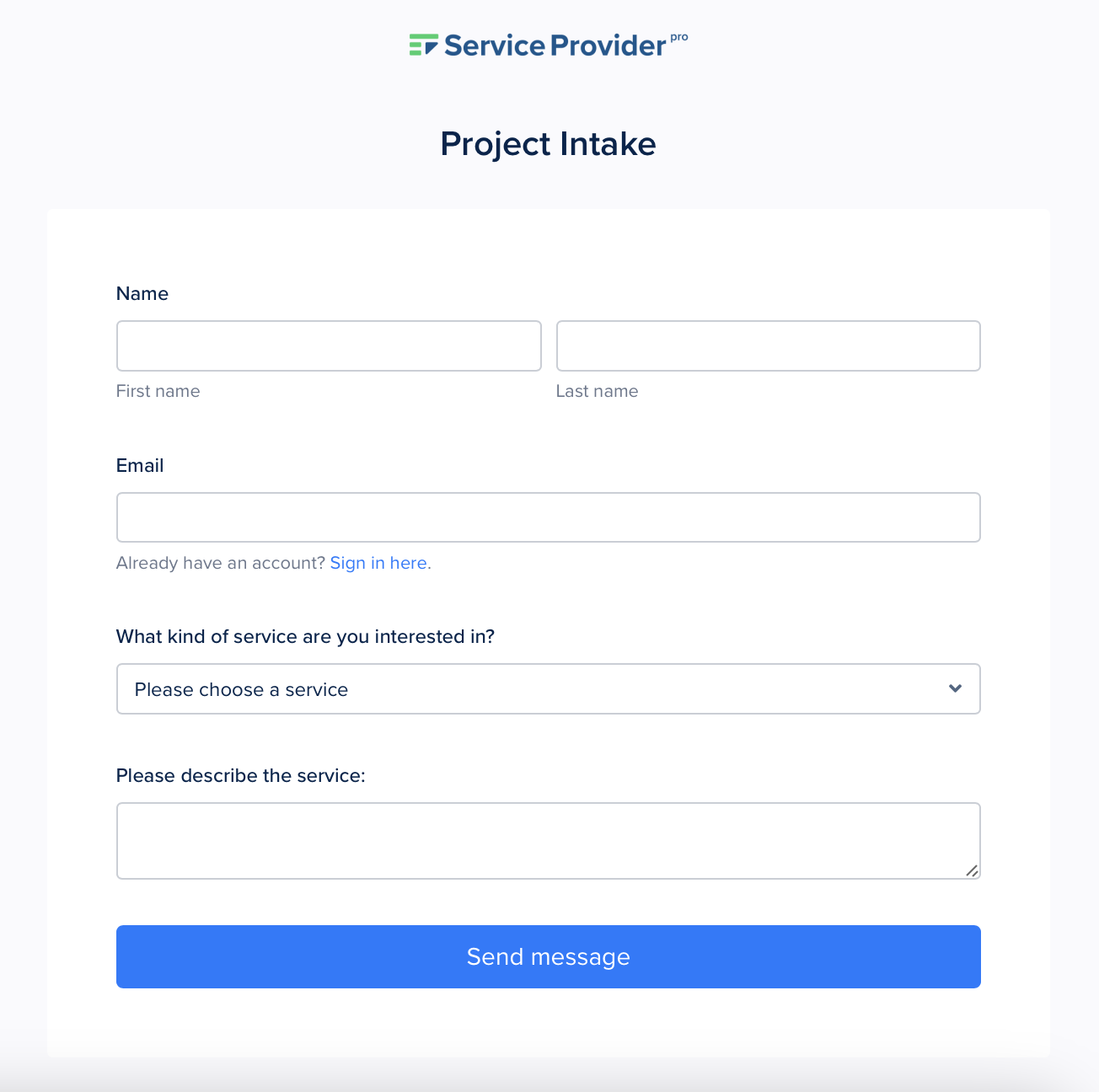
A productized service, however, can skip the introduction, jump straight to the payment, and then ask project-specific questions.
As you can see, when you create an intake form, you need to keep your work flow in mind (and building an intake process for every scenario helps with that).
With that said, there are a few things every intake form needs.
Client contact information
Every business needs accurate information about their prospective client, such as full name, business name, email address, and potentially billing address and company registration numbers.
To kick-start a conversation, you could skip the address part, as it’s not necessary yet. Ask only the most essential information, such as the first name and email address. The rest can be collected upon payment.
Client goals, needs & expectations
Once you have the basic client information, you need to start asking questions that allow you to get a better idea of the client’s requirements. Which services are they interested in, what are their expectations, and what is their business struggling with?
Make it easy for clients by designing your form in a way that doesn’t require too much text input. Create drop-downs with selection options—this makes it easier for a client to fill out the form.
Client brand information
Depending on the type of form you’re creating, you might want your client to upload brand information, such as their logo, fonts used, and other information you have to use.
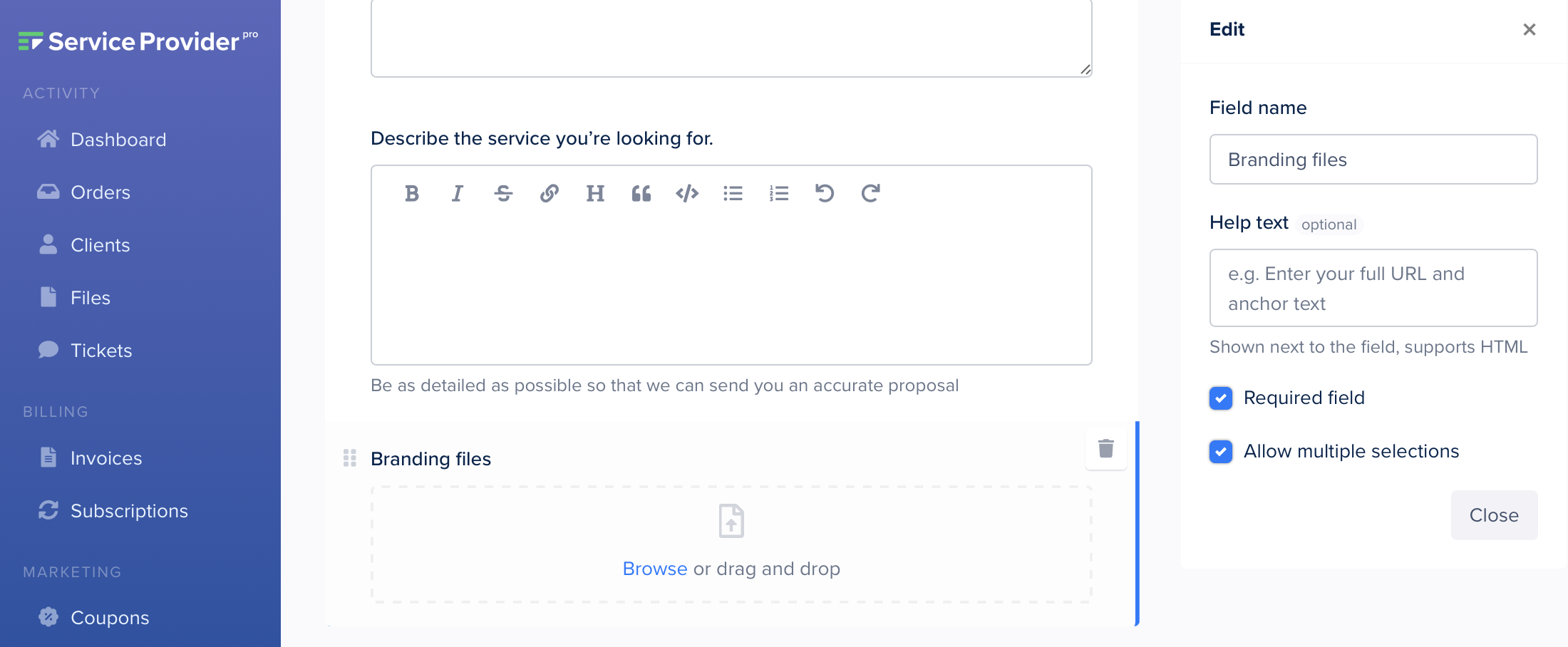
Use form fields that allow file uploads, and save the files in a client portal where your team can access them. This makes it easier to work on projects in the future as all data will be available.
Client budget
Since traditional agencies often don’t make pricing information available, they ask upfront about the budget of a potential client. If it’s unrealistic, that makes it easier for them to decline projects. The minimum option for a project should be the first choice in a budget drop-down, as it sets the right expectations with your clients.
Client e-signatures
Incorporating e-signature capabilities into your client intake form is an important step in your onboarding process. E-signatures not only make it easier for clients to sign documents but also enhance security and compliance.
Here’s how you can effectively integrate e-signature capabilities into your client intake form with SPP:
open your order form
click on the signature field
save the form
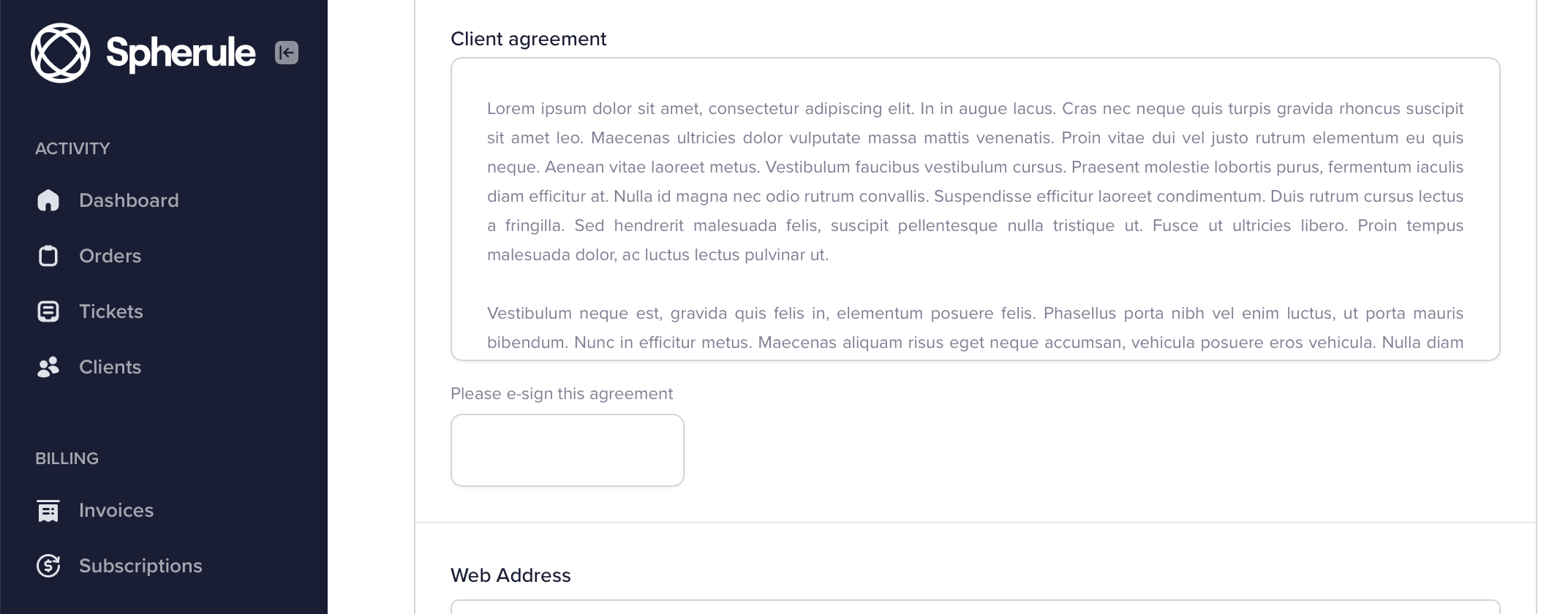
When submitted, the signature field will be transmitted securely and stored within the project data inside your orders. This includes the signature, IP address, and timestamp.
Ensuring a good user experience
Including user testimonials in your intake forms offers potential users valuable insights into real experiences, enhancing trust and credibility. Positive reviews can reassure new clients about the efficiency and security of your intake process.
Here’s what do keep in mind:
Intuitive design: By choosing a form platform such as SPP.co, it’s clean, intuitive interface will give clients confidence in your brand. Drag-and-drop features and customizable templates will make the form creation easy for you.
Clear instructions: Provide clear, concise instructions to guide users through the form, reducing errors and frustration. You can use the HTML elements to style your instructions nicely.
Progress indicators: Add progress bars to indicate how much of the form is left, which enhances transparency and encourages users to complete it.
Responsive design: Make sure your forms are responsive, adjusting smoothly to different screen sizes and devices.
Mobile optimization: Optimize forms for mobile use, with touch-friendly inputs and minimal scrolling, catering to the growing number of mobile users.
10 questions for your intake questionnaire
An effective client intake form asks the right questions. Design it in a way that it doesn’t ask irrelevant questions to topics you already know the answer to.
Here are 10 questions to inspire you to build a good client intake form:
What specific services are you seeking from our agency?
Can you provide a brief description of your business and its main operations?
What are the goals or objectives you hope to achieve with our services?
Who are your main competitors?
What’s your target demographic or customer base?
Do you have a time frame within which you expect to see results?
Are there any specific challenges that you’re currently facing?
How do you measure the success of our services?
Are there any current marketing strategies or campaigns that you’re running?
Do you need any additional support or services apart from what you have mentioned?
How to make a client intake form in 5 steps
Now that you know what kind of information you should ask, let’s look at a few ways to build an intake form from scratch.
1. Choose a form builder
There are many tools you can use to make a client intake form, for instance Google Forms, word processors such as Microsoft Word, Apple Pages or Google Docs, or software that creates PDFs.
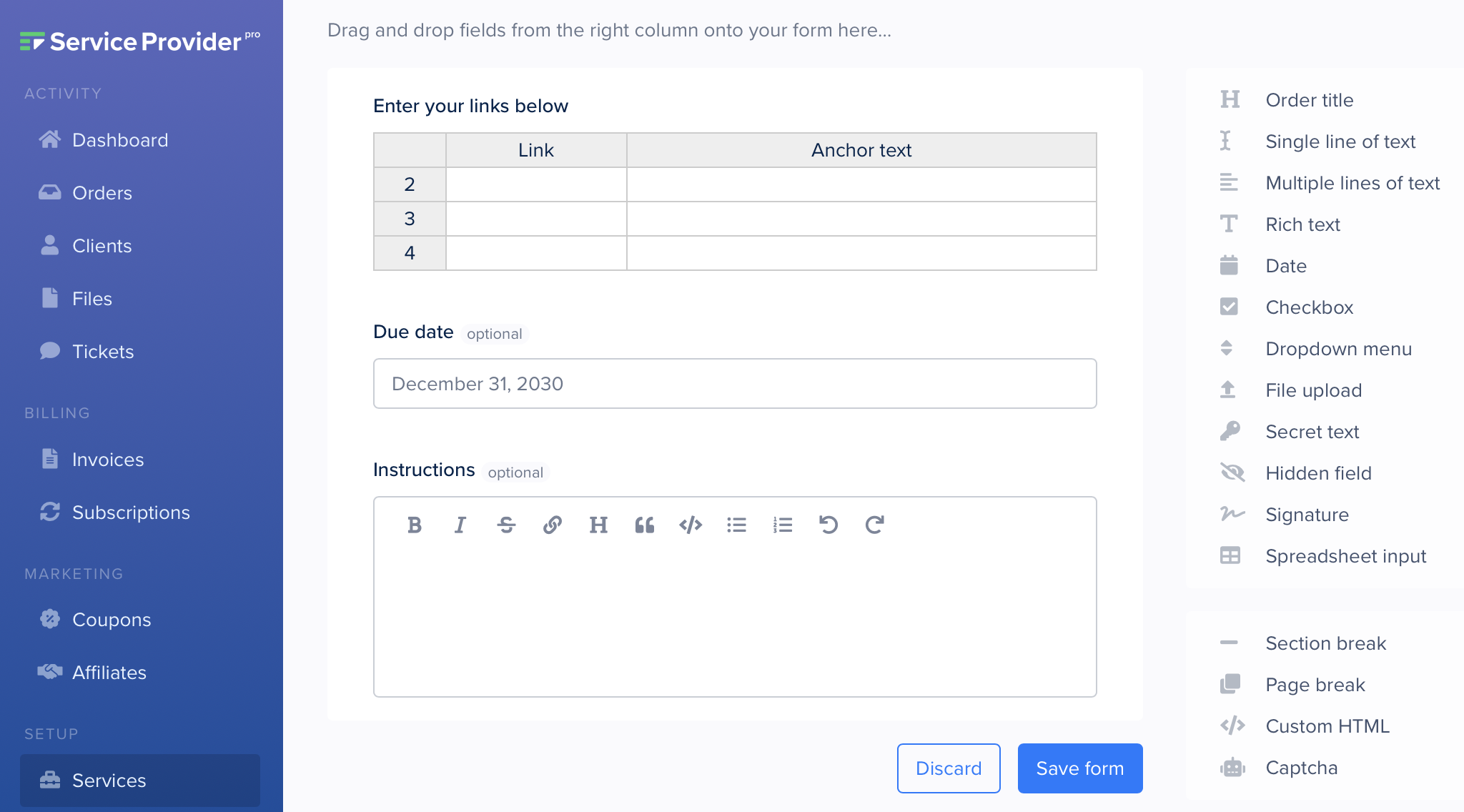
While Google Forms gets the job done, the rest are not really meant to create forms that are flexible. A better solution is to either use a dedicated tool that was built exclusively for form creation, or use Service Provider Pro and it’s powerful white label form builder.
Personalized Demo
Looking to make sure SPP is right for you? Get on a call with our customer success team.
Our tool allows you to create both contact forms via the helpdesk module (perfect for lead generation), as well as intake forms for tasks and projects. The great thing about SPP is that you can easily view the form you’ve built and preview it before you embed the form on your website.
2. Structure your intake form
To ensure that you create a simple form that doesn’t require too much time from leads and clients, structure it in a way that makes sense, for instance:
Start by asking basic contact information:
first name and last name
email address
phone number
Continue with lead generation questions:
Where have you heard about us?
What is your company’s website?
What is your industry?
Ask questions related to their inquiry:
Which services are you interested in?
What is your budget?
When is your project deadline?
Modern tools such as SPP allow you to define drop-downs that make it easy to answer these questions without having to type a single character. You can even show fields based on user selection thanks to rules. For instance, if a lead selects “Other” for the question “Where have you heard about us?”, you can show them an input field so they can fill out their answer.
Another important thing to consider when you structure your form is not to make it too long. If you have to ask a lot of questions, consider making the form multipage. In SPP, there’s a page break element that creates a new page. This makes your intake forms look less imposing.
Also keep in mind to use the appropriate fields when designing your intake form. For instance, if you request passwords, use the password field in order to keep the client information confidential.
3. Test your form
Before you send your form to clients, make sure it works, especially the rules you’ve set up to show certain elements. It’s also a good idea to time how long it takes to fill it out. Ask yourself: am I asking too many questions? Will this lead to leads/clients abandoning the form? Can I make certain questions clearer?
It’s crucial that you create client intake forms that are easy to fill out, but also give you all the information you need without follow-ups from your team. Only when you’re satisfied with the intake form for your business should you go to the next step.
4. Embed the form on your website
Online intake forms allow you to embed them on your website by linking them up with a button, or by displaying them in an iFrame. The forms created in SPP allow both scenarios—and we’re going even further.
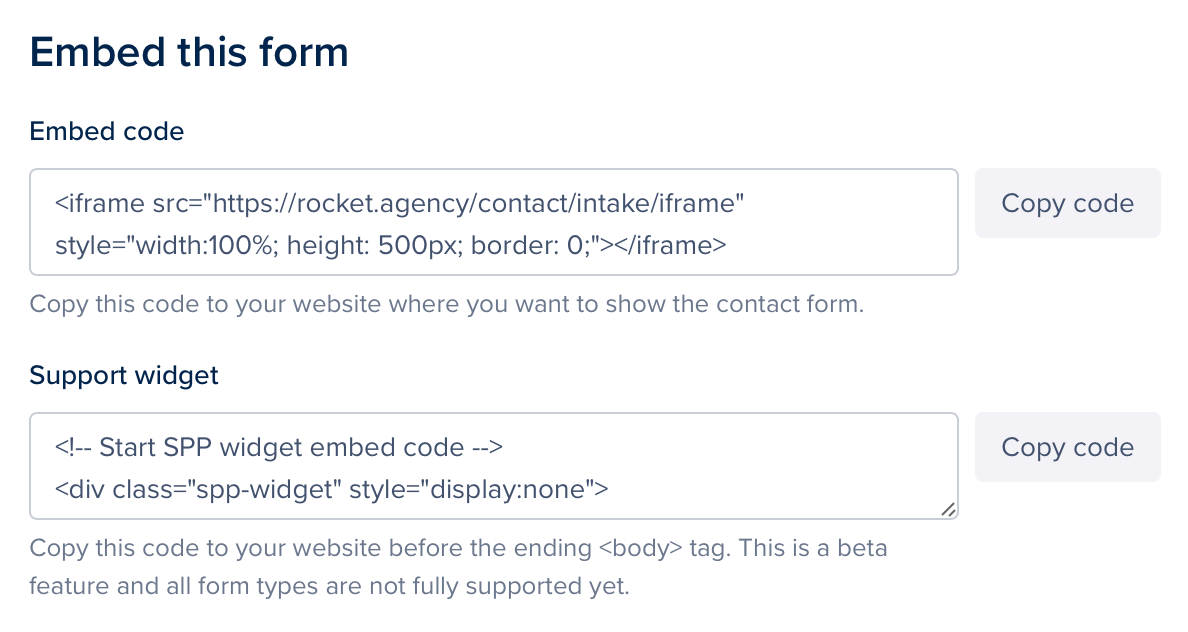
Besides the iFrame embed, you can even show a contact widget on your website. Upon clicking on it, the full form is opened. The best use-case is for simple lead generation forms, but you can also use it for your client intake.
Another feature that sets SPP’s forms apart is that you have two types of links:
A public link that anyone can access, and
a public link that logs the lead into your client portal after submission.
The second one is great if you want to give leads access to your portal so they can access certain features: they could view the services you offer, or you can show them specific information through custom pages.
5. Automate what happens next
Once your intake form has been submitted, you could trigger a variety of automations to help your team answer the client as soon as possible.
Here are a few ideas:
Based on the service selected, trigger a team note via Zapier and mention the service expert among your team members.
If the client has selected the lowest budget, tag the ticket as “low priority.”
Based on the number of characters in a “Describe your goals” field, mentioned a team member to check if the information sent is enough.
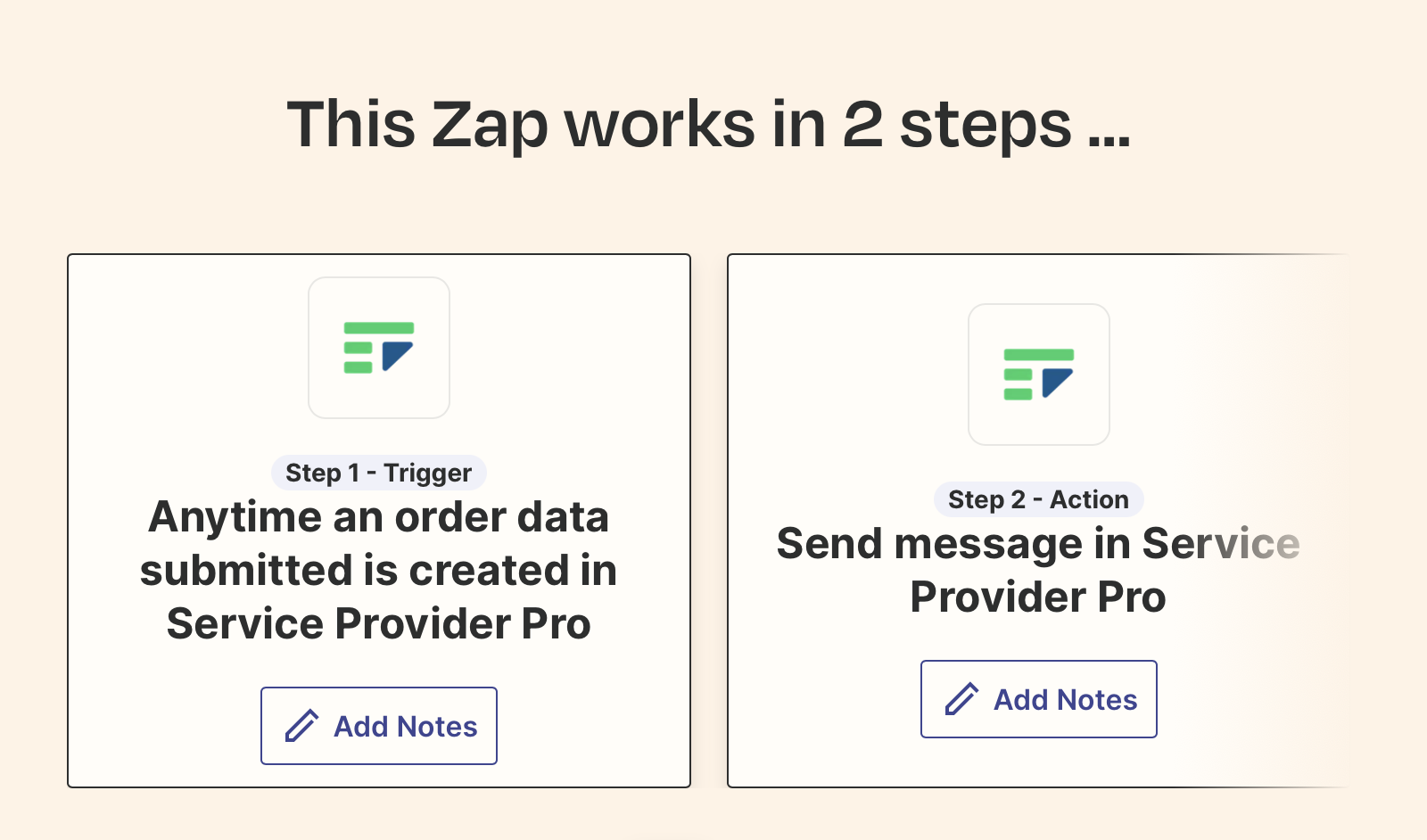
As you can see, automations can help you improve your processes due to reducing the manual input your team has to make. If the aforementioned “Describe your goals” field only has 20 characters, there’s a good chance the lead hasn’t provided enough information. In this case, a team member should follow up and ask for more details as soon as possible.
You can also send the data to your CRM or a tool to generate reports (for your clients or your internal team).
Client intake form template to get started
If you’re looking for inspiration or a template to get started, there are many sample intake forms on websites such as templates.net. You can also use the Google image search to look at the templates others have built, and replicate them in your software of choice. Keep in mind that some templates are simple graphics, others are available as PDFs, Excel or Word files. In that case, you’ll need the right software in order to view or edit them.
To make things easier for you, I’ve created a simple client intake template in Google Forms that you can use. I do recommend that you try out SPP though, as our form builder makes it very easy to build an intake form for any occasion, from client onboarding to project requests.
Create intake form FAQ
How do I make an intake form?
You can either use templates for Google Docs, Word and other tools, or use dedicated software that includes a form builder. Tools such as Service Provider Pro have a powerful form builder allowing you to build complex intake forms.
What questions should I ask on an intake form?
Depending on the nature of the intake form, you should always ask relevant information that you need to answer the client request. Don’t overwhelm them with too many questions you don’t need the answer to right away.
What is the easiest way to create a fillable form?
Google Forms and other dedicated form builders make it very easy to create a fillable form. They usually generate a unique link that you can share. SPP also allows you to build forms that can be viewed via a link, or you can embed them into your website.
What is a new client intake form?
If you have a new client, you might need to collect information about them. Send them a questionnaire asking questions about their needs and goals, their brand, and other details.
Optimize your client intake process
Using a client intake form should be a no-brainer these days. If designed correctly, you receive the information you need to create proposals, or kick-start a project.
As I’ve hopefully shown you with this guide, thanks to modern software, creating an intake form process couldn’t be easier. You’re even able to automate many parts of the intake process thanks to third party tools such as Zapier.



